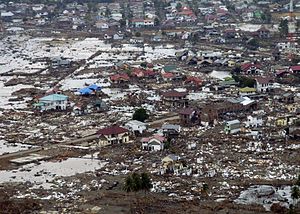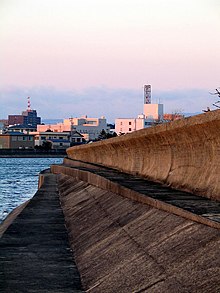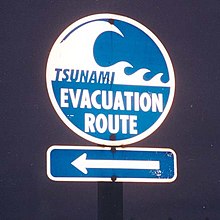Tsunami
From Wikipedia, the free encyclopedia
For other uses, see Tsunami (disambiguation).

A destroyed town in Sumatra after being hit by a tsunami, caused by the 2004 Indian Ocean earthquake
Earthquakes, volcanic eruptions and other underwater explosions (including detonations of underwater nuclear devices), landslides and other mass movements, meteorite ocean impacts or similar impact events, and other disturbances above or below water all have the potential to generate a tsunami.
The Greek historian Thucydides was the first to relate tsunami to submarine earthquakes,[5][6] but the understanding of a tsunami's nature remained slim until the 20th century and is the subject of ongoing research. Many early geological, geographical, and oceanographic texts refer to tsunamis as "seismic sea waves."
Some meteorological conditions, such as deep depressions that cause tropical cyclones, can generate a storm surge, called a meteotsunami, which can raise tides several metres above normal levels. The displacement comes from low atmospheric pressure within the centre of the depression. As these storm surges reach shore, they may resemble (though are not) tsunamis, inundating vast areas of land.
Contents[hide] |
Etymology and history

Lisbon earthquake and tsunami in 1755

The Russians of Pavel Lebedev-Lastochkin in Japan, with their ships tossed inland by a tsunami, meeting some Japanese in 1779
Tsunami are sometimes referred to as tidal waves. In recent years, this term has fallen out of favor, especially in the scientific community, because tsunami actually have nothing to do with tides. The once-popular term derives from their most common appearance, which is that of an extraordinarily high tidal bore. Tsunami and tides both produce waves of water that move inland, but in the case of tsunami the inland movement of water is much greater and lasts for a longer period, giving the impression of an incredibly high tide. Although the meanings of "tidal" include "resembling"[8] or "having the form or character of"[9] the tides, and the term tsunami is no more accurate because tsunami are not limited to harbours, use of the term tidal wave is discouraged by geologists and oceanographers.
There are only a few other languages that have an equivalent native word. In the Tamil language, the word is aazhi peralai. In the Acehnese language, it is ië beuna or alôn buluëk[10] (Depending on the dialect. Note that in the fellow Austronesian language of Tagalog, a major language in the Philippines, alon means "wave".) On Simeulue island, off the western coast of Sumatra in Indonesia, in the Defayan language the word is smong, while in the Sigulai language it is emong.[11]
Main article: Historic tsunami
As early as 426 B.C. the Greek historian Thucydides inquired in his book History of the Peloponnesian War about the causes of tsunami, and was the first to argue that ocean earthquakes must be the cause.[5][6]The cause, in my opinion, of this phenomenon must be sought in the earthquake. At the point where its shock has been the most violent the sea is driven back, and suddenly recoiling with redoubled force, causes the inundation. Without an earthquake I do not see how such an accident could happen.[12]The Roman historian Ammianus Marcellinus (Res Gestae 26.10.15-19) described the typical sequence of a tsunami, including an incipient earthquake, the sudden retreat of the sea and a following gigantic wave, after the 365 A.D. tsunami devastated Alexandria.[13][14]
While Japan may have the longest recorded history of tsunamis, the sheer destruction caused by the 2004 earthquake and tsunami event mark it as the most devastating of its kind in modern times, killing around 230,000 people. The Sumatran region is not unused to tsunamis either, with earthquakes of varying magnitudes regularly occurring off the coast of the island.[15]
Generation mechanisms
The principal generation mechanism (or cause) of a tsunami is the displacement of a substantial volume of water or perturbation of the sea.[16] This displacement of water is usually attributed to either earthquakes, landslides, volcanic eruptions, or more rarely by meteorites and nuclear tests.[17][18] The waves formed in this way are then sustained by gravity. Tides do not play any part in the generation of tsunamis.Tsunami generated by seismicity
Tsunami can be generated when the sea floor abruptly deforms and vertically displaces the overlying water. Tectonic earthquakes are a particular kind of earthquake that are associated with the Earth's crustal deformation; when these earthquakes occur beneath the sea, the water above the deformed area is displaced from its equilibrium position.[19] More specifically, a tsunami can be generated when thrust faults associated with convergent or destructive plate boundaries move abruptly, resulting in water displacement, owing to the vertical component of movement involved. Movement on normal faults will also cause displacement of the seabed, but the size of the largest of such events is normally too small to give rise to a significant tsunami.-
- Overriding plate bulges under strain, causing tectonic uplift.
- Plate slips, causing subsidence and releasing energy into water.
On April 1, 1946, a magnitude-7.8 (Richter Scale) earthquake occurred near the Aleutian Islands, Alaska. It generated a tsunami which inundated Hilo on the island of Hawai'i with a 14 metres (46 ft) high surge. The area where the earthquake occurred is where the Pacific Ocean floor is subducting (or being pushed downwards) under Alaska.
Examples of tsunami originating at locations away from convergent boundaries include Storegga about 8,000 years ago, Grand Banks 1929, Papua New Guinea 1998 (Tappin, 2001). The Grand Banks and Papua New Guinea tsunamis came from earthquakes which destabilized sediments, causing them to flow into the ocean and generate a tsunami. They dissipated before traveling transoceanic distances.
The cause of the Storegga sediment failure is unknown. Possibilities include an overloading of the sediments, an earthquake or a release of gas hydrates (methane etc.)
The 1960 Valdivia earthquake (Mw 9.5) (19:11 hrs UTC), 1964 Alaska earthquake (Mw 9.2), 2004 Indian Ocean earthquake (Mw 9.2) (00:58:53 UTC) and 2011 Tōhoku earthquake (Mw9.0) are recent examples of powerful megathrust earthquakes that generated tsunamis (known as teletsunamis) that can cross entire oceans. Smaller (Mw 4.2) earthquakes in Japan can trigger tsunamis (called local and regional tsunamis) that can only devastate nearby coasts, but can do so in only a few minutes.
In the 1950s, it was discovered that larger tsunamis than had previously been believed possible could be caused by giant landslides. These phenomena rapidly displace large water volumes, as energy from falling debris or expansion transfers to the water at a rate faster than the water can absorb. Their existence was confirmed in 1958, when a giant landslide in Lituya Bay, Alaska, caused the highest wave ever recorded, which had a height of 524 metres (over 1700 feet). The wave didn't travel far, as it struck land almost immediately. Two people fishing in the bay were killed, but another boat amazingly managed to ride the wave. Scientists named these waves megatsunami.
Scientists discovered that extremely large landslides from volcanic island collapses can generate megatsunamis that can cross oceans.
Characteristics
Tsunamis cause damage by two mechanisms: the smashing force of a wall of water travelling at high speed, and the destructive power of a large volume of water draining off the land and carrying all with it, even if the wave did not look large.While everyday wind waves have a wavelength (from crest to crest) of about 100 metres (330 ft) and a height of roughly 2 metres (6.6 ft), a tsunami in the deep ocean has a wavelength of about 200 kilometres (120 mi). Such a wave travels at well over 800 kilometres per hour (500 mph), but owing to the enormous wavelength the wave oscillation at any given point takes 20 or 30 minutes to complete a cycle and has an amplitude of only about 1 metre (3.3 ft).[21] This makes tsunamis difficult to detect over deep water. Ships rarely notice their passage.
As the tsunami approaches the coast and the waters become shallow, wave shoaling compresses the wave and its velocity slows below 80 kilometres per hour (50 mph). Its wavelength diminishes to less than 20 kilometres (12 mi) and its amplitude grows enormously. Since the wave still has the same very long period, the tsunami may take minutes to reach full height. Except for the very largest tsunamis, the approaching wave does not break, but rather appears like a fast-moving tidal bore.[22] Open bays and coastlines adjacent to very deep water may shape the tsunami further into a step-like wave with a steep-breaking front.
When the tsunami's wave peak reaches the shore, the resulting temporary rise in sea level is termed run up. Run up is measured in metres above a reference sea level.[22] A large tsunami may feature multiple waves arriving over a period of hours, with significant time between the wave crests. The first wave to reach the shore may not have the highest run up.[23]
About 80% of tsunamis occur in the Pacific Ocean, but they are possible wherever there are large bodies of water, including lakes. They are caused by earthquakes, landslides, volcanic explosions, and bolides.
Drawback
If the first part of a tsunami to reach land is a trough—called a drawback—rather than a wave crest, the water along the shoreline recedes dramatically, exposing normally submerged areas.A drawback occurs because the water propagates outwards with the trough of the wave at its front. Drawback begins before the wave arrives at an interval equal to half of the wave's period. Drawback can exceed hundreds of metres, and people unaware of the danger sometimes remain near the shore to satisfy their curiosity or to collect fish from the exposed seabed.
Scales of intensity and magnitude
As with earthquakes, several attempts have been made to set up scales of tsunami intensity or magnitude to allow comparison between different events.[24]Intensity scales
The first scales used routinely to measure the intensity of tsunami were the Sieberg-Ambraseys scale, used in the Mediterranean Sea and the Imamura-Iida intensity scale, used in the Pacific Ocean. The latter scale was modified by Soloviev, who calculated the Tsunami intensity I according to the formulaMagnitude scales
The first scale that genuinely calculated a magnitude for a tsunami, rather than an intensity at a particular location was the ML scale proposed by Murty & Loomis based on the potential energy.[24] Difficulties in calculating the potential energy of the tsunami mean that this scale is rarely used. Abe introduced the tsunami magnitude scale Mt, calculated from,Warnings and predictions
See also: Tsunami warning system
Drawbacks can serve as a brief warning. People who observe drawback (many survivors report an accompanying sucking sound), can survive only if they immediately run for high ground or seek the upper floors of nearby buildings. In 2004, ten-year old Tilly Smith of Surrey, England, was on Maikhao beach in Phuket, Thailand with her parents and sister, and having learned about tsunamis recently in school, told her family that a tsunami might be imminent. Her parents warned others minutes before the wave arrived, saving dozens of lives. She credited her geography teacher, Andrew Kearney.In the 2004 Indian Ocean tsunami drawback was not reported on the African coast or any other eastern coasts it reached. This was because the wave moved downwards on the eastern side of the fault line and upwards on the western side. The western pulse hit coastal Africa and other western areas.
A tsunami cannot be precisely predicted, even if the magnitude and location of an earthquake is known. Geologists, oceanographers, and seismologists analyse each earthquake and based on many factors may or may not issue a tsunami warning. However, there are some warning signs of an impending tsunami, and automated systems can provide warnings immediately after an earthquake in time to save lives. One of the most successful systems uses bottom pressure sensors that are attached to buoys. The sensors constantly monitor the pressure of the overlying water column. This is deduced through the calculation:
P = the overlying pressure in newtons per metre square,
ρ = the density of the seawater= 1.1 x 103 kg/m3,
g = the acceleration due to gravity= 9.8 m/s2 and
h = the height of the water column in metres.
Hence for a water column of 5,000 m depth the overlying pressure is equal to
Regions with a high tsunami risk typically use tsunami warning systems to warn the population before the wave reaches land. On the west coast of the United States, which is prone to Pacific Ocean tsunami, warning signs indicate evacuation routes. In Japan, the community is well-educated about earthquakes and tsunamis, and along the Japanese shorelines the tsunami warning signs are reminders of the natural hazards together with a network of warning sirens, typically at the top of the cliff of surroundings hills.[26]
The Pacific Tsunami Warning System is based in Honolulu, Hawaiʻi. It monitors Pacific Ocean seismic activity. A sufficiently large earthquake magnitude and other information triggers a tsunami warning. While the subduction zones around the Pacific are seismically active, not all earthquakes generate tsunami. Computers assist in analysing the tsunami risk of every earthquake that occurs in the Pacific Ocean and the adjoining land masses.
-
-
- Tsunami memorial in Kanyakumari beach
Computer models can predict tsunami arrival, usually within minutes of the arrival time. Bottom pressure sensors relay information in real time. Based on these pressure readings and other seismic information and the seafloor's shape (bathymetry) and coastal topography, the models estimate the amplitude and surge height of the approaching tsunami. All Pacific Rim countries collaborate in the Tsunami Warning System and most regularly practice evacuation and other procedures. In Japan, such preparation is mandatory for government, local authorities, emergency services and the population.
Some zoologists hypothesise that some animal species have an ability to sense subsonic Rayleigh waves from an earthquake or a tsunami. If correct, monitoring their behavior could provide advance warning of earthquakes, tsunami etc. However, the evidence is controversial and is not widely accepted. There are unsubstantiated claims about the Lisbon quake that some animals escaped to higher ground, while many other animals in the same areas drowned. The phenomenon was also noted by media sources in Sri Lanka in the 2004 Indian Ocean earthquake.[27][28] It is possible that certain animals (e.g., elephants) may have heard the sounds of the tsunami as it approached the coast. The elephants' reaction was to move away from the approaching noise. By contrast, some humans went to the shore to investigate and many drowned as a result.
Mitigation
In some tsunami-prone countries earthquake engineering measures have been taken to reduce the damage caused onshore. Japan, where tsunami science and response measures first began following a disaster in 1896, has produced ever-more elaborate countermeasures and response plans.[29] That country has built many tsunami walls of up to 4.5 metres (15 ft) to protect populated coastal areas. Other localities have built floodgates and channels to redirect the water from incoming tsunami. However, their effectiveness has been questioned, as tsunami often overtop the barriers. For instance, the Okushiri, Hokkaidō tsunami which struck Okushiri Island of Hokkaidō within two to five minutes of the earthquake on July 12, 1993 created waves as much as 30 metres (100 ft) tall—as high as a 10-story building. The port town of Aonae was completely surrounded by a tsunami wall, but the waves washed right over the wall and destroyed all the wood-framed structures in the area. The wall may have succeeded in slowing down and moderating the height of the tsunami, but it did not prevent major destruction and loss of life.[30]Natural barriers
Natural factors such as shoreline tree cover can mitigate tsunami effects. Some locations in the path of the 2004 Indian Ocean tsunami escaped almost unscathed because trees such as coconut palms and mangroves absorbed the tsunami's energy. In one striking example, the village of Naluvedapathy in India's Tamil Nadu region suffered only minimal damage and few deaths because the wave broke against a forest of 80,244 trees planted along the shoreline in 2002 in a bid to enter the Guinness Book of Records.[31] Environmentalists have suggested tree planting along tsunami-prone seacoasts. Trees require years to grow to a useful size, but such plantations could offer a much cheaper and longer-lasting means of tsunami mitigation than artificial barriers.A report published by the United Nations Environment Programme (UNEP) suggests that the tsunami of 26 December 2004 caused less damage in the areas where natural barriers were present, such as mangroves, coral reefs or coastal vegetation. A Japanese study of this tsunami in Sri Lanka used satellite imagery modelling to establish the parameters of coastal resistance as a function of different types of trees.[32]
As a weapon
There have been studies and at least one attempt to create tsunami waves as a weapon. In World War II, the New Zealand Military Forces initiated Project Seal, which attempted to create small tsunamis with explosives in the area of today's Shakespear Regional Park; the attempt failed.[33]See also
- Deep-ocean Assessment and Reporting of Tsunamis
- Disaster preparedness
- Earthquake
- Higher Ground Project
- Historic tsunamis
- List of earthquakes
- List of natural disasters
- List of tsunami films
- Megatsunami
- Meteotsunami
- Minoan eruption
- Rogue wave
- Seiche
- Sneaker wave
- Supervolcano
- Tidal bore
- Tsunami hazard in lakes
- Tsunami house
- Tsunami Society
- Tsunami warning system
- Tsunamis in the United Kingdom
Footnotes
- ^ "Tsunami Terminology". NOAA. Retrieved 2010-07-15.
- ^ Wells, John C. (1990). Longman pronunciation dictionary. Harlow, England: Longman. p. 736. ISBN 0582053838. Entry: "tsunami"
- ^ Fradin, Judith Bloom and Dennis Brindell (2008). Witness to Disaster: Tsunamis. Witness to Disaster. Washington, D.C.: National Geographic Society. pp. 42, 43.
- ^ "Answers.com". Answers.com. Retrieved 2010-08-24.
- ^ a b Thucydides: “A History of the Peloponnesian War”, 3.89.1–4
- ^ a b Smid, T. C. (Apr., 1970). 'Tsunamis' in Greek Literature. 17 (2nd ed.). pp. 100–104.
- ^ [a. Jap. tsunami, tunami, f. tsu harbour + nami waves.— Oxford English Dictionary]
- ^ "Tidal", The American Heritage Stedman's Medical Dictionary. Houghton Mifflin Company. 11 November 2008.Dictionary.reference.com
- ^ -al. (n.d.). Dictionary.com Unabridged (v 1.1). Retrieved November 11, 2008, Dictionary.reference.com
- ^ "Acehrecoveryforum.org". Acehrecoveryforum.org. 2007-11-06. Retrieved 2010-08-24.
- ^ JTIC.org[dead link]
- ^ Thucydides: “A History of the Peloponnesian War”, 3.89.5
- ^ Kelly, Gavin (2004). "Ammianus and the Great Tsunami". The Journal of Roman Studies 94 (141): 141–167. doi:10.2307/4135013. JSTOR 4135013.
- ^ Stanley, Jean-Daniel & Jorstad, Thomas F. (2005), "The 365 A.D. Tsunami Destruction of Alexandria, Egypt: Erosion, Deformation of Strata and Introduction of Allochthonous Material"
- ^ The 10 most destructive tsunamis in history, Australian Geographic, March 16, 2011.
- ^ Haugen K, Løvholt F, Harbitz C, K; Lovholt, F; Harbitz, C (2005). "Fundamental mechanisms for tsunami generation by submarine mass flows in idealised geometries". Marine and Petroleum Geology 22 (1-2): 209–217. doi:10.1016/j.marpetgeo.2004.10.016.
- ^ Margaritondo, G (2005). "Explaining the physics of tsunamis to undergraduate and non-physics students". European Journal of Physics 26 (3).
- ^ Voit, S.S (1987). "Tsunamis". Annual Review of Fluid Mechanics 19 (1): 217–236. doi:10.1146/annurev.fl.19.010187.001245.
- ^ "How do earthquakes generate tsunamis?". University of Washington.
- ^ Facts and figures: how tsunamis form, Australian Geographic, March 18, 2011.
- ^ Earthsci.org, Tsunamis
- ^ a b "Life of a Tsunami". Western Coastal & Marine Geology. United States Geographical Survey. 22 October 2008. Retrieved 2009-09-09.
- ^ Prof. Stephen A. Nelson (28-Jan-2009). "Tsunami". Tulane University. Retrieved 2009-09-09.
- ^ a b Gusiakov V.. "Tsunami Quantification: how we measure the overall size of tsunami (Review of tsunami intensity and magnitude scales)". Retrieved 2009-10-18.
- ^ Abe K. (1995). Estimate of Tsunami Run-up Heights from Earthquake Magnitudes. ISBN 9780792334835. Retrieved 2009-10-18.
- ^ Chanson, H. (2010). Tsunami Warning Signs on the Enshu Coast of Japan. Shore & Beach, Vol. 78, No. 1, pp. 52-54. ISSN 4237 0037 4237.
- ^ Lambourne, Helen (2005-03-27). "Tsunami: Anatomy of a disaster". BBC.
- ^ Kenneally, Christine (2004-12-30). "Surviving the Tsunami: What Sri Lanka's animals knew that humans didn't". Slate Magazine.
- ^ http://content.hks.harvard.edu/journalistsresource/pa/society/health/tsunami-japan/
- ^ "1993年7月12日 北海道南西沖地震" (in Japanese).
- ^ Raman, Sunil (2005-02-16). "Tsunami villagers give thanks to trees". BBC.
- ^ [1] Satellite imagery and modelling show how forests cushion the impact of tsunamis
- ^ "The Hauraki Gulf Marine Park, Part 2". Inset to The New Zealand Herald: p. 9. 3 March 2010.
References
- IOC Tsunami Glossary by the Intergovernmental Oceanographic Commission (IOC) at the International Tsunami Information Centre (ITIC) of UNESCO
- Tsunami Terminology at NOAA
- abelard.org. tsunamis: tsunamis travel fast but not at infinite speed. retrieved March 29, 2005.
- Dudley, Walter C. & Lee, Min (1988: 1st edition) Tsunami! ISBN 0-8248-1125-9 website[dead link]
- Iwan, W.D., editor, 2006, Summary report of the Great Sumatra Earthquakes and Indian Ocean tsunamis of December 26, 2004 and March 28, 2005: Earthquake Engineering Research Institute, EERI Publication #2006-06, 11 chapters, 100 page summary, plus CD-ROM with complete text and supplementary photographs, EERI Report 2006-06. ISBN 1-932884-19-X website
- Kenneally, Christine (December 30, 2004). "Surviving the Tsunami." Slate. website
- Lambourne, Helen (March 27, 2005). "Tsunami: Anatomy of a disaster." BBC News. website
- Macey, Richard (January 1, 2005). "The Big Bang that Triggered A Tragedy," The Sydney Morning Herald, p 11—quoting Dr Mark Leonard, seismologist at Geoscience Australia.
- The NOAA's page on the 2004 Indian Ocean earthquake and tsunami
- Tappin, D; 2001. Local tsunamis. Geoscientist. 11–8, 4–7.
- Girl, 10, used geography lesson to save lives, Telegraph.co.uk
- Philippines warned to prepare for Japan's tsunami, Noypi.ph
External links
| Wikimedia Commons has media related to: Tsunami |
- Animation of DART tsunami detection system
- Can HF Radar detect Tsunamis? – University of Hamburg HF-Radar.
- Envirtech Tsunami Warning System – Based on seabed seismics and sea level gauges.
- Geology.com The highest tsunami was caused by rockfall
- IOC Tsunami Glossary by the Intergovernmental Oceanographic Commission (IOC) at the International Tsunami Information Centre (ITIC) of UNESCO
- How to survive a tsunami – Guide for children and youth
- International Centre for Geohazards (ICG)
- ITSU – Coordination Group for the Pacific Tsunami Warning System.
- Jakarta Tsunami Information Centre
- National Tsunami Hazard Mitigation Program Coordinated U.S. Federal/State effort
- NOAA Center for Tsunami Research (NCTR)
- NOAA Tsunami – General description of tsunamis and the United States agency NOAA's role
- NOVA: Wave That Shook The World – Site and special report shot within days of the 2004 Indian Ocean tsunami.
- Pacific Tsunami Museum
- Science of Tsunami Hazards journal
- Tsunami scientific publications list
- Scientific American Magazine (January 2006 Issue) Tsunami: Wave of Change What we can learn from the Indian Ocean tsunami of December 2004.
- Social & Economic Costs of Tsunamis in the United States from "NOAA Socioeconomics" website initiative
- Tsunami Centers – United States National Weather Service.
- Tsunami database with detailed statistics
- Interactive map of recent and historical tsunami events with links to graphics, animations and data
- Tsunami Warning – Tsunami warnings via mobile phone.
- Tsunamis and Earthquakes
- USGS: Surviving a tsunami (United States)
- Impact of Tsunami on groundwater resources IGRAC International Groundwater Resources Assessment Centre
- Tsunami Surges on Dry Coastal Plains: Application of Dam Break Wave Equations, Coastal Engineering Journal, 48 4: 355-370
Images, video, and animations
- Amateur Camcorder Video Streams of the December 26, 2004 tsunami that hit Sri Lanka, Thailand and Indonesia (search on tsunamis)
- Animation of 1960 tsunami originating outside coast of Chile
- Animations of actual and simulated tsunami events from the NOAA Center for Tsunami Research
- CBC Digital Archives – Canada's Earthquakes and Tsunamis
- Computer-generated animation of a tsunami
- Origin of a Tsunami - animation showing how the shifting of continental plates in the Indian Ocean created the catastrophe of December 26, 2004.
- Photos and Videos of Humanitarian Assistance to Tsunami-hit areas by the Singapore Armed Forces
- Tsunami Aftermath in Penang and Kuala Muda, Kedah.
- Satellite Images of Tsunami Affected Areas High resolution satellite images showing the effects of the 2004 tsunami on the affected areas in Indonesia, Thailand and Nicobar island of India.
- The Survivors - A moving travelogue full of stunning images along the tsunami ravaged South-Western Coast of India (Unavailable)
- Animations of tsunami propagation model results for actual tsunami events
- 2004 Boxing Day Tsunami at YouTube
- Raw Video: Tsunami Slams Northeast Japan, a video of the 2011 Tōhoku (Japan) earthquake tsunami by Associated Press at YouTube, showing the wave from a tsunami engulfing a town and farmlands.


















